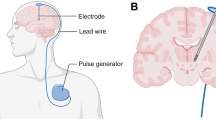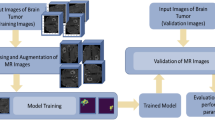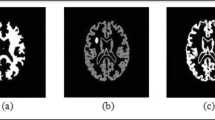Abstract
Purpose
Deep brain stimulation (DBS) is a procedure requiring accurate targeting and electrode placement. The two key elements for successful planning are preserving patient safety by ensuring a safe trajectory and creating treatment efficacy through optimal selection of the stimulation point. In this work, we present the first approach of computer-assisted preoperative DBS planning to automatically optimize both the safety of the electrode’s trajectory and location of the stimulation point so as to provide the best clinical outcome.
Methods
Building upon the findings of previous works focused on electrode trajectory, we added a set of constraints guiding the choice of stimulation point. These took into account retrospective data represented by anatomo-clinical atlases and intersections between the stimulation region and sensitive anatomical structures causing side effects. We implemented our method into automatic preoperative planning software to assess if the algorithm was able to simultaneously optimize electrode trajectory and the stimulation point.
Results
Leave-one-out cross-validation on a dataset of 18 cases demonstrated an improvement in the expected outcome when using the new constraints. The distance to critical structures was not reduced. The intersection between the stimulation region and structures sensitive to stimulation was minimized.
Conclusions
Introducing these new constraints guided the planning to select locations showing a trend toward symptom improvement, while minimizing the risks of side effects, and there was no cost in terms of trajectory safety.





Similar content being viewed by others
References
Baegert C, Essert-Villard C, Schreck P, Soler L, Gangi A (2007) Trajectory optimization for the planning of percutaneous radiofrequency ablation of hepatic tumors. Comput Aided Surg 12(2):82–90
Baegert C, Villard C, Schreck P, Soler L (2007) Multi-criteria trajectory planning for hepatic radiofrequency ablation. In: Proceedings of MICCAI’07. Springer LNCS, vol 4791, pp 584–592
Baker KB, Boulis NM, Rezai AR, Montgomery EB Jr (2004) Target selection using microelectrode recording. In: Israel Z, Burchiel KJ (eds) Microelectrode recordings in movement disorder surgery. Thieme, New York, pp 138–151
Bériault S, Drouin S, Sadikot AF, Xiao Y, Collins DL, Pike GB (2013) A prospective evaluation of computer-assisted deep brain stimulation trajectory planning. In: Proceedings of CLIP’12. Springer LNCS, vol 7761, pp 42–49
Bériault S, Subaie F, Mok K, Sadikot A, Pike GB (2011) Automatic trajectory planning of DBS neurosurgery from multi-modal MRI datasets. In: Proceedings of MICCAI’11. Springer LNCS, vol 6891, pp 259–266
Bériault S, Xiao Y, Bailey L, Collins D, Sadikot A, Pike G (2012) Towards computer-assisted deep brain stimulation targeting with multiple active contacts. In: Proceedings of MICCAI’12. Springer LNCS, vol 7510, pp 487–494
Bourbakis N, Awad M (2003) A 3-D visualization method for image-guided brain surgery. IEEE Trans Syst Man Cybern B Cybern 33(5):766–781
Brunenberg E, Vilanova A, Visser-Vandewalle V, Temel Y, Ackermans L, Platel B, ter Haar Romeny B (2007) Automatic trajectory planning for deep brain stimulation: a feasibility study. In: Proceedings of MICCAI’07. Springer LNCS, vol 4791, pp 584–592
Butson CR, McIntyre CC (2005) Role of electrode design on the volume of tissue activated during deep brain stimulation. J Neural Eng 3(1):1
Butson C, Cooper S, Henderson J, McIntyre C (2007) Patient-specific analysis of the volume of tissue activated during deep brain stimulation. NeuroImage 34:661–670
Chaturvedi A, Butson CR, Lempka SF, Cooper SE, McIntyre CC (2010) Patient-specific models of deep brain stimulation: influence of field model complexity on neural activation predictions. Brain Stimul 3(2):65–77
Chaturvedi A, Luján J, McIntyre C (2013) Artificial neural network based characterization of the volume of tissue activated during deep brain stimulation. J Neural Eng 10(5):056,023
D’Albis T, Haegelen C, Essert C, Fernandez-Vidal S, Lalys F, Jannin P (2014) Pydbs: an automated image processing workflow for deep brain stimulation surgery. Int J Comput Assist Radiol Surg, pp 1–12
Essert C, Haegelen C, Lalys F, Abadie A, Jannin P (2012) Automatic computation of electrodes trajectories for deep brain stimulation: a hybrid symbolic and numerical approach. Int J Comput Assist Radiol Surg 7(4):517–532
Essert C, Fernandez-Vidal S, Capobianco A, Haegelen C, Karachi C, Bardinet E, Marchal M, Jannin P (2015) Statistical study of parameters for deep brain stimulation automatic preoperative planning of electrodes trajectories. Int J Comput Assist Radiol Surg. https://doi.org/10.1007/s11548-015-1263-5
Fujii T, Emoto H, Sugou N, Mito T, Shibata I (2003) Neuropath planner-automatic path searching for neurosurgery. In: Proceedings of CARS’03. Elsevier, vol 1256, pp 587–596
Haegelen C, Coupé P, Fonov V, Guizard N, Jannin P, Morandi X, Collins DL (2013) Automated segmentation of basal ganglia and deep brain structures in mri of Parkinson’s disease. Int J Comput Assist Radiol Surg 8(1):99–110
Hamze N, Voirin J, Collet P, Jannin P, Haegelen C, Essert C (2016) Pareto front vs. weighted sum for automatic trajectory planning of deep brain stimulation. In: Medical image computing and computer assisted intervention (MICCAI’16), LNCS. Springer, vol 9900, pp 534–541
Herzog J, Fietzek U, Hamel W, Morsnowski A, Steigerwald F, Schrader B, Weinert D, Pfister G, Muller D, Mehdorn H, Deuschl G, Volkmann J (2004) Most effective stimulation site in subthalamic deep brain stimulation for Parkinson’s disease. Mov Disord 19(9):1050–1099
Jaberzadeh A, Essert C (2014) Multi-probe three-dimensional placement planning for liver cryosurgery: comparison of different optimization methods. In: Proceedings of CMMSE’14, vol 3, pp 743–754
Lalys F, Haegelen C, Maroua M, Drapier S, Verin M, Jannin P (2013) Anatomo-clinical atlases correlate clinical data and electrode contact coordinates: application to subthalamic deep brain stimulation. J Neurosci Methods 212(2):297–307
Lalys F, Haegelen C, Abadie A, Jannin P (2009) Post-operative assessment in deep brain stimulation based on multimodal images: registration workflow and validation. In: Proceedings of SPIE medical imaging, vol 7261(1), p 72612M
Lee J, Huang C, Lee S (2002) Improving stereotactic surgery using 3-D reconstruction. IEEE Eng Med Biol Mag 21(6):109–116
Liu Y, Konrad P, Neimat J, Tatter S, Yu H, Datteri R, Landman B, Noble J, Pallavaram S, Dawant B, D’Haese PF (2014) Multisurgeon, multisite validation of a trajectory planning algorithm for deep brain stimulation procedures. IEEE Trans Biomed Eng 61(9):2479–2487
Maks C, Butson C, Walter B, Vitek J, McIntyre CC (2009) Deep brain stimulation activation volumes and their association with neurophysiological mapping and therapeutic outcomes. J Neurol Neurosurg Psychiatry 80:659–666
Mehri M, Lalys F, Maumet C, Haegelen C, Jannin P (2012) Analysis of electrodes’ placement and deformation in deep brain stimulation from medical images. In: Proceedings of SPIE medical imaging, vol 8316(1), p 831632
Mikos A, Bowers D, Noecker A, McIntyre C, Won M, Chaturvedi A, Foote K, Okun M (2011) Patient-specific analysis of the relationship between the volume of tissue activated during dbs and verbal fluency. Neuroimage 54S1:238–246
Navkar N, Tsekos N, Stafford J, Weinberg J, Deng Z (2010) Visualization and planning of neurosurgical interventions with straight access. In: Proceedings of IPCAI’10. Springer LNCS, vol 6135, pp 1–11
Nelder J, Mead R (1965) A simplex method for function minimization. Comput J 7(4):308–313. https://doi.org/10.1093/comjnl/7.4.308
Nowinski W, Yang G, Yeo T (2002) Computer-aided stereotactic functional neurosurgery enhanced by the use of the multiple brain atlas database. IEEE Trans Med Imaging 19(1):62–69
Pallavaram S, D’Haese PF, Lake W, Konrad PE, Dawant BM, Neimat JS (2015) Fully automated targeting using non-rigid image registration matches accuracy and exceeds precision of best manual approaches to subthalamic deep brain stimulation targeting in Parkinson’s disease. Neurosurgery 76(6):756–765
Saint-Cyr J, Hoque T, Pereira L, Dostrovsky J, Hutchison W, Mikulis D, Abosch A, Sime E, Lang A, Lozano A (2002) Localization of clinically effective stimulating electrodes in the human subthalamic nucleus on magnetic resonance imaging. J Neurosurg 97:1152–1166
Shamir R, Tamir I, Dabool E, Joskowicz L, Shoshan Y (2010) A method for planning safe trajectories in image-guided keyhole neurosurgery. In: Proceedings of MICCAI’10. Springer LNCS, vol 6363, pp 457–464
Tirelli P, de Momi E, Borghese N, Ferrigno G (2009) An intelligent atlas-based planning system for keyhole neurosurgery. In: Computer assisted radiology and surgery supplemental, pp S85–S91
Tisch S, Zrinzo L, Limousin P, Bhatia K, Quinn N, Ashkan K, Hariz M (2007) Effect of electrode contact location on clinical efficacy of pallidal deep brain stimulation in primary generalised dystonia. J Neurol Neurosurg Psychiatry 78:1314–1319
Vaillant M, Davatzikos C, Taylor R, Bryan R (1997) A path-planning algorithm for image-guided neurosurgery. In: Proceedings of CVRMed-MRCAS’97. Springer LNCS, vol 1205, pp 467–476
Zhang TC, Grill WM (2010) Modeling deep brain stimulation: point source approximation versus realistic representation of the electrode. J Neural Eng 7(6):066,009
Acknowledgements
This work was funded by the French National Research Agency (ANR) through the ACouStiC Project Grant (ANR 2010 BLAN 0209 02).
Author information
Authors and Affiliations
Corresponding author
Ethics declarations
Conflict of interest
All authors declare that they have no conflict of interest.
Ethical approval
All procedures performed in studies involving human participants were in accordance with the ethical standards of the institutional and/or national research committee and with the 1964 Helsinki Declaration and its later amendments or comparable ethical standards.
Informed consent
Informed consent was obtained from all individual participants included in the study.
Rights and permissions
About this article
Cite this article
Dergachyova, O., Zhao, Y., Haegelen, C. et al. Automatic preoperative planning of DBS electrode placement using anatomo-clinical atlases and volume of tissue activated. Int J CARS 13, 1117–1128 (2018). https://doi.org/10.1007/s11548-018-1724-8
Received:
Accepted:
Published:
Issue Date:
DOI: https://doi.org/10.1007/s11548-018-1724-8




